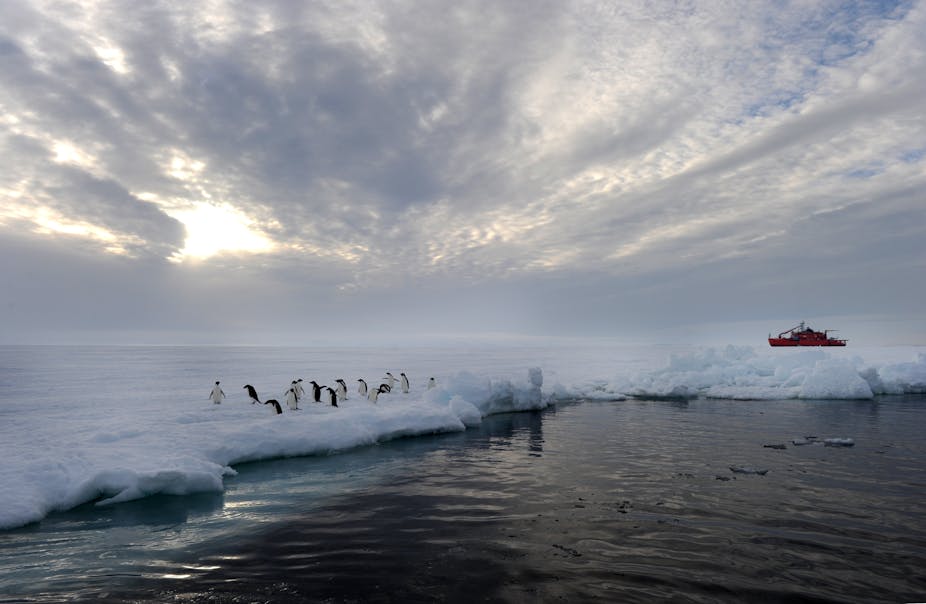Despite recent commentary in the media, Australia’s proclamation of its extended continental shelf does not represent new “claims” in Antarctica and does not contravene the Antarctic Treaty. With Australia hosting Antarctic Treaty meetings in Hobart in mid-June 2012, it is timely to look at how the Antarctic Treaty and the United Nations Law of the Sea intersect on Australia’s recent action.
What has Australia done?
On May 24 2012 Australia made the Seas and Submerged Lands (Limits of Continental Shelf) Proclamation 2012 which defines the outer limits of Australia’s continental shelf. The proclamation describes the 11 million square kilometres of seabed over which Australia can exercise exclusive rights to seabed resources. The area of extended continental shelf so defined is greater than the land mass of Australia.
Australia was able to make this proclamation because it had fulfilled its obligations under the United Nations Convention on the Law of the Sea (UNCLOS). UNCLOS came into effect for Australia in 1994. In 2004, within the 10-year deadline set by the Convention, Australia, the third country after Russia and Brazil, submitted data defining its extended continental shelf to the UN’s Commission on the Limits of the Continental Shelf (CLCS).
The recent proclamation by Australia reflects the consideration of the CLCS. It legally defines the area over which Australia can exercise rights to its extended continental shelf.

(The figure also shows those areas between Australia and Indonesia and East Timor, and north-east of Norfolk Island, where delimitation between Australia and other countries is still under active diplomatic discussion.)
Two areas of Australia’s extended continental shelf extend south of 60 degrees South into the Antarctic Treaty area. The largest of these areas is the extended continental shelf arising from the Territory of Heard Island and McDonald Islands between Australia and South Africa. The other is from Macquarie Island between Tasmania and Antarctica. Macquarie Island is part of the state of Tasmania.
Does this proclamation conflict with the Antarctic Treaty?
The short answer is no. Article IV of the Antarctic Treaty provides inter alia that “no new claim, or enlargement of an existing claim, to territorial sovereignty in Antarctica shall be asserted while the present Treaty is in force”. But the proclamation of Australia’s extended continental shelves relating to Heard Island and Macquarie Island are neither new claims “to territorial sovereignty in Antarctica” nor “enlargement of an existing claim to territorial sovereignty in Antarctica”.
Both the Territory of Heard Island and the McDonald Islands, and Macquarie Island lie outside the Antarctic Treaty area. The extended continental shelves that they generate under the Law of the Sea arise outside of Antarctica and exist because of Australia’s unchallenged sovereignty to these areas. That they extend into the Antarctic Treaty area is a matter of geography, not international law. Besides, the area of continental shelf is not a territorial claim, it is an area where rights can be exercised because a territorial claim already exists on land.
Does this proclamation mean that Australia can mine in the Antarctic Treaty area?
The short answer to this question is also no. The Protocol on Environmental Protection to the Antarctic Treaty (Madrid Protocol) prohibits mining in the Antarctic Treaty area (all the area south of 60 degrees south). Australia has enacted domestic legislation to fulfil its obligations under the Madrid Protocol, including the prohibition on mining.

Australia could not mine in the Antarctic Treaty area on those parts of its extended continental shelf without breaching its international obligations. But Australia could, for example, use its powers derived from the proclamation of its extended continental shelf to stop countries which are not signatories to the Madrid Protocol from engaging in mineral activities in these areas.
Will other countries be surprised by what Australia has done?
Many countries will be attending the Antarctic Treaty meetings in Hobart in mid-June 2012. But they won’t be taken aback: there are no legal or diplomatic surprises in Australia’s proclamation. Australia submitted the data required to define its extended continental shelf to the UN’s CLCS on November 16 2004.
Australia had already engaged in wide-ranging diplomatic discussions about how to handle the data it collected from its survey of the extended continental shelf arising from the Australian Antarctic Territory (ie from the continent of Antarctica, not from the rest of Australia). Other Antarctic countries were well-prepared for Australia’s submission.
In a well-orchestrated move, Australia requested the CLCS to not examine for the time being the Antarctic data. The diplomatic responses from some Antarctic Treaty Parties reflected the discussions among Antarctic Treaty parties in the lead up to Australia’s submission.
There is nothing in Australia’s proclamation of 24 May 2012 that is new or surprising. The proclamation does not cover areas appurtenant to the Antarctic continent and the Antarctic status quo remains.

